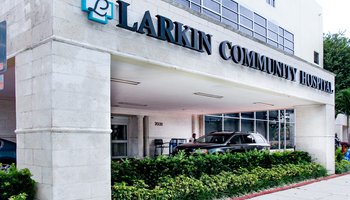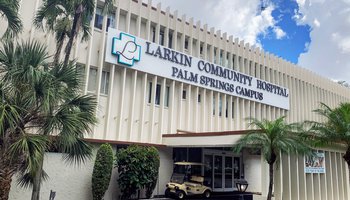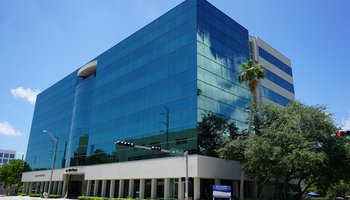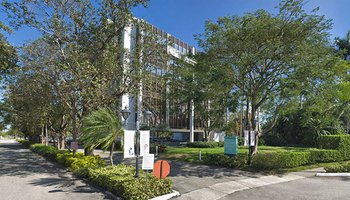- Home »
- Treatments & Services »
- Orthopedics
Surgical and Non-Surgical Solutions
for Musculoskeletal Disorders, Degenerative Diseases, & Trauma
Larkin Community Hospital is Joint Commission Certified in Core Hip and Knee Replacement
We are proud to announce that Larkin Community Hospital has earned The Joint Commission’s Certification for Core Hip and Knee Replacement. This prestigious certification recognizes our commitment to providing safe, high-quality care and exceptional outcomes for patients undergoing joint replacement surgery.
Our orthopedic team follows evidence-based standards and best practices from pre-surgical evaluation through post-operative care, ensuring every patient receives comprehensive, coordinated care.
This certification is a testament to the expertise of our surgeons, nurses, therapists, the entire orthopedic team and our ongoing dedication to excellence in joint replacement surgery.
Orthopedic Services at Larkin
At Larkin Health System, we understand that musculoskeletal health is crucial for maintaining an active and fulfilling life. Our Orthopedic Department is dedicated to delivering top-tier care that addresses a wide range of musculoskeletal conditions and injuries, helping our patients return to their everyday activities with improved mobility and reduced pain.
Comprehensive Orthopedic Care
Our team of highly trained and experienced orthopedic specialists is committed to providing comprehensive care tailored to meet the unique needs of each patient. Whether you are dealing with a sports injury, degenerative joint disease, or a complex orthopedic condition, our multidisciplinary team works collaboratively to develop a personalized treatment plan that aligns with your health goals.
Expertise and Innovation
Larkin Health System is proud to house some of the leading experts in orthopedic medicine. Our board-certified surgeons and specialists are at the forefront of their fields, utilizing the latest advancements in medical technology and surgical techniques to ensure the highest standard of care. We stay on top of cutting-edge research and innovations in orthopedics, ensuring that our patients receive the most effective and up-to-date treatments available.
Patient-Centered Approach
At the heart of our orthopedic services is a commitment to patient-centered care. We prioritize open communication, ensuring that you are informed and involved in every step of your treatment journey. Our compassionate team is dedicated to providing a supportive and empathetic environment where your concerns are heard, and your comfort and safety are prioritized.
Comprehensive Surgical and Non-Surgical Treatments
Our orthopedic services encompass a wide range of both surgical and non-surgical treatments. We offer advanced surgical procedures, including joint replacements, spine surgery, sports medicine interventions, trauma care, and hand and upper extremity surgery. For those seeking non-surgical solutions, we provide expert care in physical therapy, pain management, and lifestyle counseling. Our goal is to provide holistic care that not only addresses symptoms but also enhances overall well-being.
State-of-the-Art Facilities
Larkin Health System is equipped with state-of-the-art facilities and cutting-edge technology to support our orthopedic services. Our advanced imaging and diagnostic tools allow for precise evaluation and treatment planning, while our modern surgical suites and rehabilitation centers ensure that you receive comprehensive care under one roof.
Our Services
Our orthopedic surgical team specializes in a variety of procedures to help restore function, reduce pain, and improve the quality of life for our patients. We utilize the latest surgical techniques and state-of-the-art technology to ensure optimal outcomes.
Symptoms to Watch For
If you are experiencing any of the symptoms listed below, it is important to seek the advice of a medical professional. Early diagnosis and treatment can prevent further complications and improve your quality of life.
Pain, Swelling, or Inflammation
Joint
- Persistent or recurring pain in any joint
- Swelling, tenderness, or redness around the joint
- Stiffness, especially in the morning or after periods of inactivity
- Limited range of motion
Knee
- Pain when walking, bending, or straightening the knee
- Swelling or stiffness
- Popping or crunching noises
- Instability or inability to fully extend the knee
Hip
- Pain in the groin, thigh, or outer buttock area
- Stiffness or difficulty moving the hip
- Swelling or tenderness
- Pain that worsens with activity or prolonged sitting
Wrist
- Pain or tenderness, especially when gripping or lifting objects
- Swelling or warmth around the wrist
- Numbness or tingling in the fingers
- Weakness or difficulty holding objects
Ankle
- Pain when bearing weight on the ankle
- Swelling, bruising, or tenderness
- Stiffness or limited range of motion
- Instability or repeated ankle sprains
Muscle
- Persistent muscle pain or soreness
- Swelling or tenderness in the affected muscle
- Muscle weakness or cramps
- Limited ability to move the affected area
Neck
- Pain or stiffness, especially in the back of the neck
- Pain that radiates to the shoulders or arms
- Numbness or tingling in the arms or hands
- Limited range of motion or difficulty turning the head
Low Back
- Persistent or sharp pain in the lower back
- Pain that radiates to the buttocks or legs
- Stiffness or difficulty standing up straight
- Numbness or tingling in the legs
- Pain, Swelling, Inflammation, Numbness, or Weakness
Arm
- Pain or tenderness in the upper or lower arm
- Swelling or redness
- Numbness or tingling in the arm or fingers
- Weakness or difficulty lifting or holding objects
Leg
- Pain or aching in the thigh, calf, or foot
- Swelling or inflammation
- Numbness or tingling in the leg or toes
- Weakness or difficulty walking or standing
Hand
- Pain or stiffness in the fingers or palm
- Swelling or redness
- Numbness or tingling in the fingers
- Weakness or difficulty gripping or holding objects
- Difficulty with Using
Hands
- Difficulty gripping, holding, or manipulating objects
- Pain, stiffness, or swelling in the fingers or wrist
- Numbness or tingling, particularly in the thumb, index, and middle fingers
- Loss of fine motor skills
Legs
- Difficulty walking, standing, or climbing stairs
- Pain, stiffness, or swelling in the hips, knees, or ankles
- Numbness or tingling in the legs or feet
- Weakness or instability when bearing weight
If you experience any of these symptoms, it is important to consult with an orthopedic specialist. Early intervention can help diagnose the underlying cause and determine the best treatment plan for your condition. At Larkin, our team of experienced professionals is here to provide you with the highest quality care and support.
- Musculoskeletal Disorders
- Spine Disorders
- Extremity Disorders
- Arthritis
- Back pain
- Bunions
- Bursitis
- Carpal Tunnel Syndrome
- Dislocation
- Fibromyalgia
- Fractures
- Golfer's or Baseball Elbow (Medial Epicondylitis)
- Incontinence
- Kyphosis
- Lymphedema
- Osteoporosis
- Osteoarthritis (hip, knee, and hands)
- Paget's Disease of the bone
- Sciatica
- Scoliosis
- Soft Tissue Injuries
- Strains, Sprains, Tears
- ACL
- LCL
- MCL
- PCL
- Rotator Cuff
- Hip Labral
- Tarsal Tunnel Syndrome
- Temporomandibular Joint Disorders (TMD)
- Tennis Elbow (Lateral Epicondylitis)
- Trauma Related Injuries
- Sports
- Accident
Our exceptional team of Physicians and Physical and Occupational Therapists delivers the highest standards of care. Our commitment to personalized attention and hand-on approach to therapy facilitates our patients’ return to the activities that enhance their lives.
Services:
- Neuromuscular Medicine
- Osteopathic Manipulative Medicine
- Sports Medicine
- Physical Therapy
- Occupational Therapy
- Speech Therapy
- Neurological
- Rehabilitation
- Cardiopulmonary
- Balance
- Spinal
- Pre/Post surgery
- Pain Management
- Pain Relievers
- Anti-inflammatories
- Injections
- Acupuncture
- Fall Prevention
- Manual Therapy
- Massage Therapy
- Craniosacral Therapy
- Platelet Rich Plasma Therapy
- Prolotherapy
Total Hip Replacement
Total hip replacement is a surgical procedure in which a prosthetic implant replaces the hip joint.
Total Hip Revision
It is the redoing of a previously done failed total hip replacement.
Total Knee Replacement
Total knee replacement is a surgical procedure in which a prosthetic implant replaces the knee joint.
Total Knee Revision
It is the redoing of a previously done failed total knee replacement.
Core Decompression of the Shoulder, Knee, or Hip
It is a surgical procedure where the internal bone pressure in the shoulder, knee, or hip is relieved by drilling a hole into the bone.
Open Reduction and Internal Fixation (ORIF) of the Hip
ORIF is a surgical procedure that involves the surgical correction of fractures and the implantation of hardware to stabilize and guide the repair of bone.
Injections
It is liquid into the joints and bursas with a syringe.
Robotic-Assisted Surgery
It is any surgical procedure where the surgeon’s skills are complemented by using a mechanical arm to increase precision and reproducibility.
Anterior Hip Replacement
Anterior total hip replacement is a surgical procedure in which a prosthetic implant replaces the hip joint, and it is performed from an incision located in front of the hip. This contrasts with the standard approach where the incision is located on the side of the hip.
Partial Knee Replacement
Partial knee replacement is a surgical procedure in which a prosthetic implant replaces only one knee joint compartment. This contrasts with total knee replacements, where all three knee compartments are replaced.
Before Your Surgery
Preparing for your surgery is an important step in ensuring a smooth procedure and a successful recovery. At Larkin Orthopedic, we are committed to providing you with the best care and guidance throughout your surgical journey. Please review the following steps and guidelines to help you prepare for your upcoming surgery.
Refer to our educational packets for more information:
- Preparing for Surgery Packet
- Obesity, Weight loss, BMI, and Joint Replacement Surgery
- Preparing For Surgery
- Physical Conditioning
- Sleep Apnea
- Staph Infections
- Depression
- Surgical Site Skin Preparation
- Diabetes Mellitus
- Anemia
- Opioid/ Narcotic Drug Use
- Varicose Veins, Leg Swelling, and Blood Clots
- High Blood Pressure/ Hypertension
- Smoking
- Obesity
- Diet and Nutrition
Pre-Surgical Consultation
Before your surgery, you will have a consultation with your orthopedic surgeon. During this visit, your surgeon will:
Review your medical history and any current medications.
Discuss the details of your surgery, including the procedure, risks, and benefits.
Answer any questions you may have about the surgery and recovery process.
Pre-Operative Testing
You may be required to undergo several tests before your surgery to ensure you are in optimal health. These tests may include:
Blood tests
X-rays or other imaging studies
Electrocardiogram (EKG)
Other tests as determined by your surgeon
Day of Surgery
On the day of your surgery:
Arrive at the hospital or surgical center at the designated time.
Wear comfortable clothing and leave valuables at home.
Follow any additional instructions provided by your surgeon or the hospital staff.
Contact Information
If you have any questions or concerns before your surgery, please do not hesitate to contact our office. Our team is here to support you and ensure you are fully prepared for your procedure.
We look forward to providing you with the highest quality of care at Larkin Orthopedic. Your health and well-being are our top priorities.
Educational links:
- Orthopaedic Surgery and Smoking - OrthoInfo - AAOS
- Preparing for Surgery: Health Condition Checklist - OrthoInfo - AAOS
- Obesity, Weight Loss, and Joint Replacement Surgery - OrthoInfo - AAOS
- Total Hip Replacement - OrthoInfo - AAOS
- Osteoarthritis of the Knee Animation - OrthoInfo -AAOS
- Total Knee Replacement - OrthoInfo - AAOS
- Knee Exercises - OrthoInfo - AAOS
You may be in the Hospital anywhere from 2 to 5 days depending on the specific type of procedure that you receive and how fast you recuperate. The first day you will get out of bed and attempt to walk. Our experienced Physical Therapy team will work with you starting the day of surgery. Most patients will have a catheter in their bladder so that you won’t have to worry about urination in the first 24 hours. This catheter is usually removed the next day after the surgery. Initially you will start walking with a walker and we will move you on to crutches or a cane as soon as our team deems it safe.
Keep your wound clean and dry at all times and do not allow anyone to put any ointments or any other substances on the wound. We prefer dry dressing changes only.
Staples are removed anywhere from Days 10 to 14 from the day of surgery for most patients or at Day 18-21 for diabetic or rheumatoid patients. This happens either at the Rehab Center/Skilled Nursing Facility or at home by the Home Health Team.
Steri-strips will then be applied to the wound. These strips will then fall off on their own. Please DO NOT remove them. We allow you to shower 2 days after the steri-strips have been applied.
You will be on a blood thinner anywhere from 4 or 6 weeks. It is most important that you have your blood drawn at least once a week to monitor the thinning out level during that time.
Please wear the special stockings we prescribed for you at all times for 6 weeks after the surgery.
Normally we allow patients to drive anywhere between 3 and 8 weeks from the day of surgery.
If you have any wound drainage, excessive pain, redness or warmth, fever or chills after your surgery please call our office immediately.
Do not allow anyone to prescribe you any type of antibiotics without our knowledge and prior authorization.
You will either be full weight bearing as tolerate or you will be allowed partial weight bearing until your hip or knee heals.
We continue our hip replacement precautions for a total time of 6 weeks.
Arthritis: inflammation of joints due to infectious, metabolic, or constitutional causes
Arthroscopy: a minimally invasive surgical procedure involving visual examination of the interior of a joint with an arthroscope to diagnose or treat various conditions or injuries of a joint and especially to repair or remove damaged or diseased tissue or bone
Anterior Cruciate Ligament (ACL): a cruciate ligament of each knee that attaches the front of the tibia with the back of the femur and functions especially to prevent hyperextension of the knee and is subject to injury especially by tearing
— called also ACL
Arthrogram: a radiograph of a joint made by arthrography.
Arthrography: the radiographic visualization of a joint (as the hip or shoulder) after the injection of a radiopaque substance.
Bursa: a small serous sac between a tendon and a bone.
Bursitis: inflammation of a bursa (as of the shoulder or elbow)
Cartilage: elastic tissue that composes most of the skeleton of vertebrate embryos and except for a small number of structures (such as some joints, respiratory passages, and the external ear) is replaced by bone during ossification in the higher vertebrates
Computed Tomography Scan (Also called a CT or CAT scan): radiography in which a three-dimensional image of a body structure is constructed by computer from a series of plane cross-sectional images made along an axis
— called also computed axial tomography, computerized axial tomography, computerized tomography
Dislocation: displacement of one or more bones at a joint.
Femur: the proximal bone of the hind or lower limb that extends from the hip to the knee
— called also thighbone
Inflammation: a local response to cellular injury that is marked by capillary dilatation, leukocytic infiltration, redness, heat, and pain and that serves as a mechanism initiating the elimination of noxious agents and of damaged tissue.
Joint: the point of contact between elements of an animal skeleton with the parts that surround and support it.
Ligaments: a tough fibrous band of tissue connecting the articular extremities of bones or supporting an organ in place.
Lateral Collateral Ligament (LCL): a ligament of the outer knee that connects the lateral epicondyle of the femur with the lateral side of the head of the fibula and that helps to stabilize the knee by preventing lateral dislocation
— called also fibular collateral ligament, LCL
Musculoskeletal System: the complex system that includes: bones, joints, ligaments, tendons, muscles, and nerves. of, relating to, or involving both musculature and skeleton.
Magnetic Resonance Imaging (MRI): a noninvasive diagnostic technique that produces computerized images of internal body tissues and is based on nuclear magnetic resonance of atoms within the body induced by the application of radio waves
— called also MRI
Medial Collateral Ligament (MCL): a ligament of the inner knee that connects medial parts of the femur and tibia and helps to stabilize the knee joint — called also MCL
Menisci: a crescent or crescent-shaped body.
Osteoarthritis: a common form of arthritis typically with onset during middle or old age that is characterized by progressive degenerative changes in the cartilage of one or more joints (as of the knees, hips, and hands) accompanied by thickening and overgrowth of adjacent bone and that is marked symptomatically chiefly by stiffness, swelling, pain, deformation of joints, and loss of range of motion —abbreviation OA
Osteoporosis: a condition that affects especially older women and is characterized by decrease in bone mass with decreased density and enlargement of bone spaces producing porosity and fragility.
Posterior Cruciate Ligament (PCL): a cruciate ligament of each knee that attaches the back of the tibia with the front of the femur and functions especially to limit the backward motion of the tibia.
Prosthesis: an artificial device to replace or augment a missing or impaired part of the body.
Rheumatoid Arthritis: a usually chronic autoimmune disease that is characterized especially by pain, stiffness, inflammation, swelling, and sometimes destruction of joints —abbreviation RA.
Synovial Membrane: the dense connective-tissue membrane that secretes synovial fluid and that lines the ligamentous surfaces of joint capsules, tendon sheaths where free movement is necessary, and bursae.
Synovial Fluid: a transparent viscid lubricating fluid secreted by a membrane of an articulation, bursa, or tendon sheath.
Tendon: a tough cord or band of dense white fibrous connective tissue that unites a muscle with some other part (such as a bone) and transmits the force which the muscle exerts.
Tendonitis: inflammation of a tendon typically associated with acute injury and usually accompanied by pain and swelling,
Tibia: the inner and usually larger of the two bones of the vertebrate hind or lower limb between the knee and ankle.
Ultrasound: the diagnostic or therapeutic use of ultrasound and especially a noninvasive technique involving the formation of a two-dimensional image used for the examination and measurement of internal body structures and the detection of bodily abnormalities
— called also sonography
X-ray: any of the electromagnetic radiations that have an extremely short wavelength of less than 100 angstroms and have the properties of penetrating various thicknesses of all solids, of producing secondary radiations by impinging on material bodies, and of acting on photographic films and plates as light does.
These are Web-based resources for hip and knee replacement patients and their families. The following links to Internet sites are compiled from a variety of sources that are not linked to Larkin Health System and do not constitute medical advice. Larkin Health System does not provide any warranties on the accuracy, timeliness or availability of these sites, which represent the individual opinions of the site owners and are not necessarily endorsed by Larkin. The information is intended to help you become educated about your options and find support from other individuals facing total hip or knee replacement. People seeking specific medical advice or assistance should contact an orthopedic surgeon or other health care provider.
Miami Institute for Joint Reconstruction
The Hip
The Hip National Osteonecrosis Foundation
Implants
Wheeless’ Textbook: Total Hip Arthroplasty
Wheeless’ Textbook: Total Knee Arthroplasty
The Knee Society
The Knee Society
The Hip Society
The Hip Society
Arthritis Foundation
Arthritis Foundation
Facilities
Orthopedics | Larkin Health Please Visit or Call The Following Facilities.
Physicians
Physicians Treating Orthopedics | Larkin Health.






